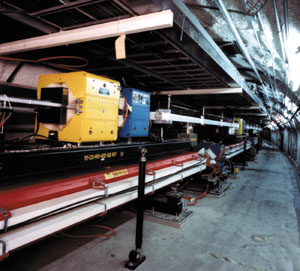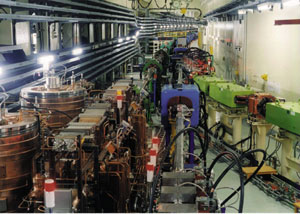
The year 2000 sees the debut of a new kind of precision physics. It formally began with the opening plenary talks at the International Conference on High Energy Physics, the biennial particle physics jamboree, held this year in Osaka.

On 31 July the initial plenary speakers at Osaka – David Hitlin of Caltech and Hiroaki Aihara of Tokyo – presented the first physics results from the BaBar and BELLE detectors respectively. A small but paradoxically important effect called CP violation has now been seen and measured outside its traditional hunting ground, which had been limited to studies of neutral kaons.
BaBar and BELLE operate at new electron_positron colliders – BaBar at the PEP-II machine at SLAC, Stanford, and BELLE at KEKB at the Japanese KEK laboratory. These colliders started operating for physics in 1999 with the aim of achieving high luminosities (collision rates) to mass-produce B-mesons – particles containing the fifth “beauty” quark, hence their name “B factories”. The commissioning of both machines has been impressive, and they are routinely delivering luminosities in excess of 1033/cm2/s – figures previously unheard of.
Physicists think that the delicate charge-parity (CP) violation effect, or matter-antimatter asymmetry, played a major role in shaping the particle scenario that emerged from the Big Bang. The initial explosion that created the universe presumably produced equal amounts of matter and antimatter. The convention is that CP violation then moulded the universe so that it eventually emerged with antimatter apparently erased from the map.
For CP symmetry the physics of left-handed particles is the same as that of right-handed antiparticles. In 1964, physicists discovered that, in the decays of one of the neutral kaons (the long-lived variety), CP symmetry is respected only 99.997% of the time. This tiny violation is enough to define which is positive and which is negative electric charge – the positive-negative assignment is not just convention.
Subsequent precision experiments have probed CP violation in depth, revealing even smaller effects that operate at the quark level. At a few parts per million, these effects are difficult to see and even harder to measure, and it has taken some 20 years for experiments to approach a consensus.
Quarks transform into each other under the action of the weak force, and the various possible quark transformations have been studied extensively and documented in the Cabibbo-Kobayashi-Maskawa (CKM) matrix of quark coupling strengths. According to these numbers, CP violation in the decays of B mesons should be easier to see than in the neutral kaon case.
The results
At Osaka it was announced that PEP-II has delivered an impressive 16 inverse femtobarns of accumulated luminosity since last May, of which the BaBar team has 14 on tape. The collider is running well and is already exceeding the design goal of 135 inverse picobarns per day. For the measurements presented at Osaka, BaBar uses only this year’s data, corresponding to about 10 inverse femtobarns.
The CP violation measurement uses B decays into J/psi and a short-lived kaon, with several different kaon decay modes, and into psi prime and a short-lived kaon. A total of 120 reconstructed events are used to determine the sin(2b) CP violating parameter. The Babar result is 0.12 ± 0.37 ± 0.09. For a check, CP asymmetries of channels that should not have any CP violation, for instance J/psi and a positive kaon, are consistent with zero.
The PEP-II plan is to extend this year’s run until October, collecting 25 inverse femtobarns (BaBar aimed for 30 inverse femtobarns, so they are right there from the start). BELLE at KEKB uses the full data sample since the start-up, corresponding to 6.8 inverse femtobarns. The luminosity reached so far is 2.04 × 1033. The decay channels used for the determination of the sin(2b) CP-violating parameter include, in addition to those used at PEP-II, B decays into chi-c1 and decays giving long-lived kaons. (BaBar has about 89 of these but doesn’t include them yet.) A total of 98 events enter the final BELLE CP fit. For J/psi Ks events only, the BELLE result is sin(2b) = 0.49 + 0.53 – 0.57. Combining this with a result from other events yields sin(2ß) = 0.45 + 0.43 – 0.44 + 0.07 – 0.09. Statistically, this is within one standard deviation of previous determinations/expectations. BELLE checked that decay channels not expected to show CP asymmetry give a null result. Plans are for BELLE to resume running with higher currents in October until summer 2001.
The upshot
The first results from BaBar and BELLE show that CP violation happens in B decays. Forget briefly about comparing the results with predictions. The fact that the effect can be measured for B-particles so soon after the debut of two innovative machines and two challenging new experiments is a major achievement and bodes well for the continued vigour of this new branch of particle physics. It look a long time before all of the CP violation parameters in neutral kaon decay were known with confidence. The B sector will probably consolidate much faster.
Fermilab’s Tevatron proton-antiproton collider is also a prolific source of B particles, and the CDF experiment there made an earlier brave attempt to measure CP violation in B decays. This environment is cluttered and the signal difficult to measure, but an effect was almost certainly there. With the advent of the PEP-II and KEKB B-factories, the study of matter-antimatter asymmetry enters a new era. For the longer-term future, other experiments are setting their sights on B physics – HERA-B at DESY, Hamburg, BTeV at Fermilab and LHCb at CERN’s LHC collider.
With reporting from Ariane Frey, CERN.





